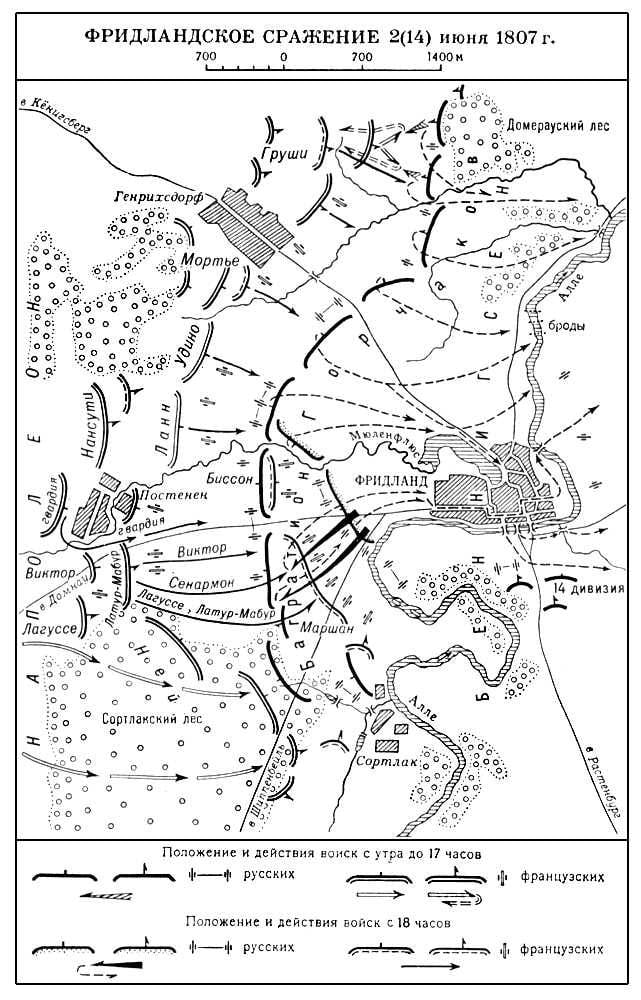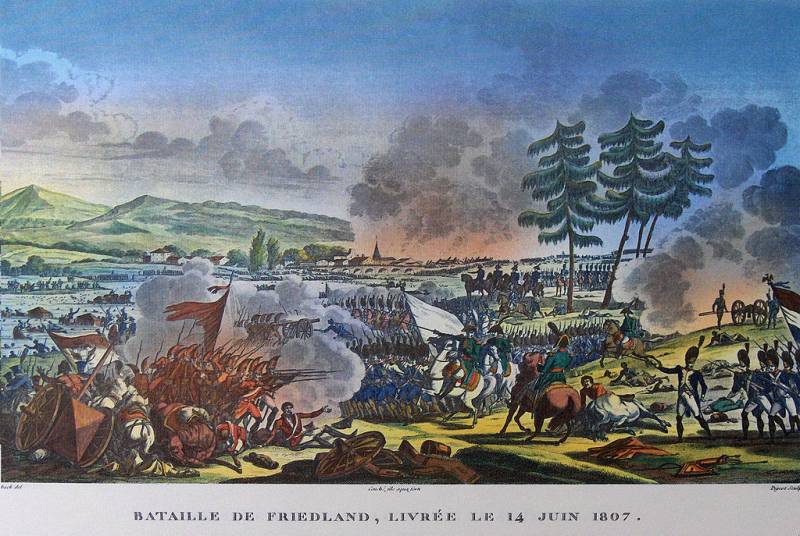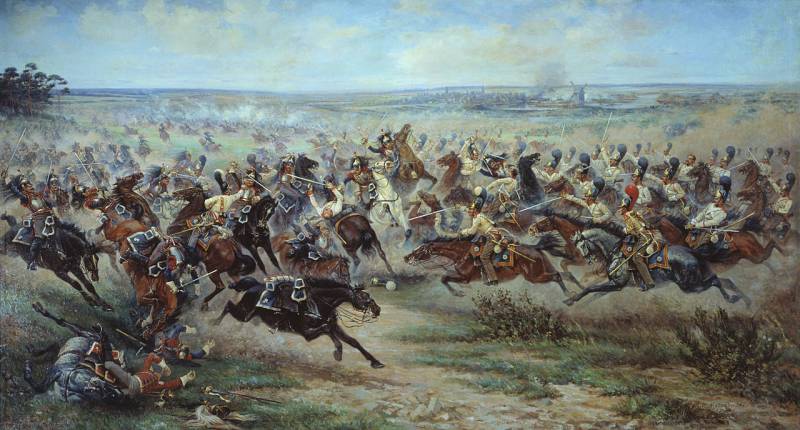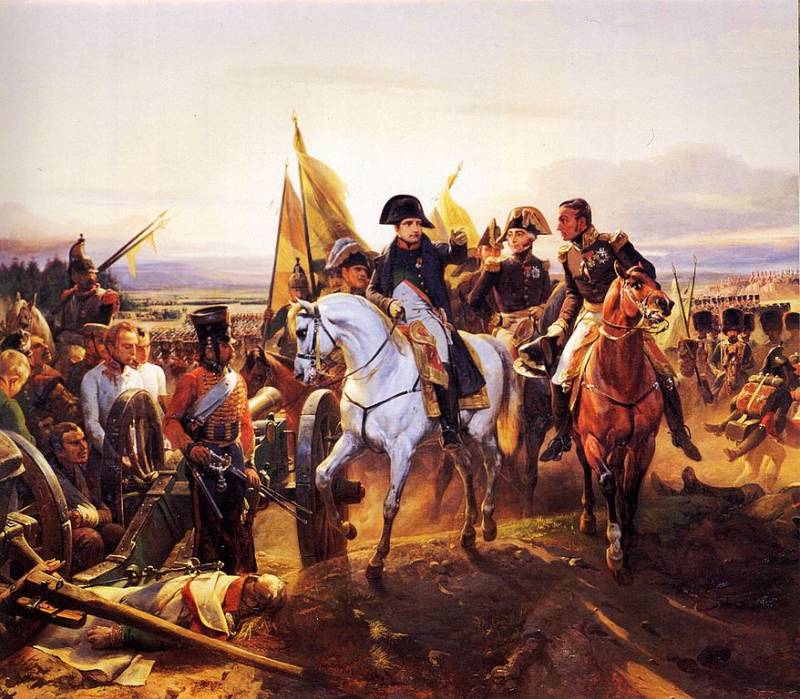Friedland Battle
After the Heilsberg Battle, Bennigsen planned to continue the battle the next day. On the night of 30 on May 31 (June 11-12), our troops were preparing to repel the enemy's new attacks: the battle lines were reinforced by reserves, in their place from the right bank of the r. Alla passed the guard. In the morning the Russian army was ready to continue the battle. A skirmish of advanced forces began, but the battle did not resume. In the evening, Napoleon led the army to Landsberg. French generals expressed fears that the Russians would take their rear lines. However, Napoleon was confident that Bennigsen would not decide on this and would be more wary of his operating lines. This is what happened.
Having received information about the movement of significant enemy forces to Landsberg, the Russian commander-in-chief ordered Count Kamensky to rush through Bertenstein to join up with the Prussians of Lestoc to defend the capital of East Prussia. Bennigsen himself was hesitant. Follow Napoleon and attack the enemy, he was afraid. It was advisable to withdraw beyond the Pregel River, or Bischofshteyn, Russell and Aris, taking a strong position, then go beyond the Narew, in both cases it was possible to get reinforcements and save an efficient army. But in this case, the Russians left East Prussia to the enemy, which led to the surrender of the Prussian king. Still in doubt, Bennigsen hurried to save Konigsberg. On the night of May 31 (June 12), the Russian army moved to the right bank of the Allee and moved to Bertenstein. From there, having received news of the appearance of the enemy at Domnau, the Russian army headed for Friedland.
Location of armies
1 (13) June, the first to Friedland came out the vanguard of Prince Golitsyn and received the news that the cities were occupied by the French from the Lannes corps. Golitsyn threw in the attack of the Lancers. They knocked the enemy out of the city, capturing the 60 man. Soon the guards' cavalry Kologrivov and the rest of the Russian army approached. Captured by the French, the vanguard of the Lannes corps is located 3 versts from Friedland. Bennigsen ordered Dokhturov to cross the 7 and 8 divisions to the left bank of Alla, reinforcing Kologrivov’s vanguard. All other troops, as they stayed to Friedland, were located on the right bank. Bennigsen planned to move to Velau on the river. Pregel, to attack the French army in the flank and rear, if it goes to Konigsberg.
Late in the evening, when reconnaissance reported to Bennigsen about the connection of Oudino’s avant-garde with the rest of Lann’s forces, he ordered the guards and two divisions to move to Allah. The guard is located at the Sortlak forest. Two pontoon bridges were built on the river. The Cossacks Platov and part of the regular cavalry were sent down the river with the aim of occupying the crossings near Allenburg and on the Pregel River. Lunn informed Napoleon about the concentration of a significant part of the Russian army on the left bank of the Alle, near Friedland, and occupied the roads leading to Konigsberg. He decided to gain time before the remaining troops. Napoleon sent Victor's corps to Lanna, and continued the movement of the remaining troops to the capital of East Prussia from Eylau to Domnau. However, having received a new report from Lanna, Napoleon turned his main forces towards Friedland.
Early in the morning of June 2 (14), the French began a firefight with Russian units with the aim of keeping them in unprofitable positions. Lannes skillfully arranged his corps, numbering 12 thousand, in such a way that the real forces of the French were hidden from the Russian command by the hills, forests, and thick rye. This made it seem that a large part of the French army was stationed at Friedland. Believing in this demonstration, the Russian commander-in-chief transferred almost the entire army to the left bank - about 60 thousand people, and prepared to attack the enemy. The Russian army was in a bad position: our forces were concentrated in the open area and were clearly visible, in the center was a deep ravine and Lake Mühlenflis, in the rear - the Alle river. Through the ravine had to build bridges.
To the right of the lake are the 3-I, 4-I, 6-I and 7-I divisions and most of the cavalry under the command of Prince Gorchakov, stretching his right wing to the forest. On the left flank the rest of the troops under the authority of Prince Bagration. On the right bank of Alla, only the 14 Division remained. Thus, Bennigsen’s mistake was that he knocked his army into a heap in the narrow bend of the Alle river, and in case of failure, the army could be saved only through the Friedland Bridge, located in its rear. Inside the position there were no strongholds convenient for defense, where it was possible to restrain the enemy.

Battle
Up to about 7 hours, Russian troops arrived at the bridgehead, and when they came out to the battlefield, they were engaged in a fruitless exchange of fire with the enemy. Meanwhile, the strength of the French gradually increased to 33 thousand people. A squad of Latour-Mobour, the Victor corps, the Nansuti dragoon division and the cuirassier Pears approached Lann. Gradually, the battle flared up, it was especially hot on the left flank, near the Sortlak forest. The Russian avant-garde was attacked by cavalry and infantry coming out of the Sortlak forest. The Russian cavalry was overturned by a swift attack and hid behind infantry lines. At o'clock in the morning several Russian infantry battalions and the Alexandria Hussars regiment attacked the enemy and drove the French into the depths of the forest. On the right flank there were several cavalry skirmishes with varying success. Thus, because of the indecision and ignorance of Bennigsen, during this period, the opportunity was missed to strike the French with superior forces before the approach of help and to break the enemy’s advanced forces.
At 12 hours, the French emperor arrived on the battlefield and immediately appreciated the weakness of the position occupied by the enemy. Having examined the battlefield, Napoleon decided to surround and destroy the Russian army after the arrival of reinforcements. At the same time overestimated the Russian forces. He ordered Murat to leave Soult’s corps against Koenigsberg and hurry with the reserve cavalry and Davout corps to Friedland. Meanwhile, new French troops arrived: Ney and Mortier corps, guards and reserve cavalry. Ney is located on the right of the French wing, between Postenin and Sortlak forest; Lannes and Dragoons - in the center, adjoining Postenen on the right flank; Maurier, Pears' cuirassiers and one dragoon division are on the left flank, at Heinrichsdorf. The Victor corps, the guard and the dragoon division of Lagusse were left in reserve in the center of the position.
By the 17 clock, Napoleon decided to attack the Russian army. He already had the advantage in the forces and at the end of the day he concentrated up to 85 thousand bayonets and sabers. The marshals tried to persuade Napoleon to postpone the beginning of the attack the next day. But the emperor, given the obviously unfortunate disposition of the Russian army, replied: “No, no, twice the enemy is not caught by such an error,” and ordered the offensive to begin immediately. Ney's troops, behind him Victor, the guard, the dragoons Lagusse and Latour-Maubura were to attack the Russian left wing, overthrow the enemy, rush into the city and seize the crossing, cutting off the withdrawal path of the Russian right wing forces behind the ravine. Marshal Mortier, who was on the left flank of the French and commanded the center of Lannes, received orders to restrain Gorchakov’s attacks. This task was facilitated by the fact that Mortier held fortified positions in the village of Heinrichsdorf, and Lunn was strengthened on the hill Postenen from the night. After the French right wing broke into Friedland and the crossing, Mortier and Lannes were to go on the offensive, completing the defeat of the Russian army.
Meanwhile, Bennigsen was inactive, although he received information about the arrival of large enemy forces. And Bagration predicted a serious attack, which will lead to the left flank and asked for reinforcements. After some doubts, the commander-in-chief still ordered 5 to retreat to the left bank of Allah. Thus, as a result of indecision, Bennigsen lost his superiority and initiative. He failed to break up Lanna before Napoleon arrived, and when the enemy gained superiority, he doubted to the last, without giving the order to withdraw.
Prince Gorchakov said that he could not retreat in full view of the enemy, it was necessary to hold on to darkness. Bagration ordered the rear units to retreat. As soon as our troops began to retreat, the corps of Ney after the shootout occupied the Sortlak forest, then came out of it and captured the village of Sortlak, reaching the river. Marchand's division was advancing on the right wing of the corps, and Bisson on the left. Marchant's troops unexpectedly came under fire from a Russian battery from the right bank of Allah. Carthy shelling mixed the French ranks. Napoleon threw Du Pont's division to help Marchand, but was late. Russian cavalry cut into the ranks of the upset Marchant division and crushed it, captured the eagle. Then the Russian cavalry rushed to the horse battery of the Du Pont division, but was overturned by the canister and the dragoon division of Latour-Maubourg. Victor and the troops of the Guard also rushed to her.
General Senarmon assembled all the artillery of the Victor Corps (36 guns), built it near the troops of Bagration and opened the most severe fire, literally shooting our troops. Surprised by the unexpected appearance of a powerful enemy battery, ours tried to respond with separate batteries, but the French suppressed them with concentrated fire. After suppressing the artillery wing Bagration, Senarmon began shelling infantry and cavalry. The first Russian line faltered. Several regiments of the second line, including the Guards huntsmen, Izmailovsky and the Horse Guards, bravely rushed to the enemy. But they were swept away by the strongest fire and suffered great losses. So, from a 520 man of the 3 battalion of the Izmailovsky regiment, about a quarter of an hour, about 400 people were killed and wounded.
The forces of Bagration, still stubbornly resisting, began to retreat. Our troops retreated into the space between Alla and the ravine, and with each step, the space became less and less. As a result, Russian troops suffered heavy losses from the actions of the French artillery. Senarmon pulled the guns very close to the Russian order (several dozen fathoms) and shot them point-blank. All this time, Napoleon personally led the battle under enemy fire and expressed concern that Senarmon was too close to the Russians. The brave general replied: “Do not disturb me and my gunners. Report to the emperor that I vouch for success. " The Russian cavalry again attempted to attack the enemy, but was upset and at retreat multiplied the confusion of our troops. Our best commanders Bagration, Rayevsky, Ermolov, Baggovut, Markov and others tried to restore order. But the French can still resisted the Russian ranks and the enemy rushed forward with shouts: “Long live the emperor!” Baggovut and Markov fell wounded. Bagration rallied Moscow Grenadier Regiment, reminded soldiers of the glory of Suvorov, the victories in Italy. Moscow grenadiers fearlessly rushed to the attack, but were discarded. Russians desperately resisted, went to counterattacks, suffered huge losses, but they were crowded. The best guards units suffered huge losses.
The participant of the battle Yermolov described this moment in the following way: “All the troops began to retreat to the bridges; to the main of them the road goes through the city; and in the streets from the constraints there was a great mess that multiplied the action of the enemy artillery facing the city. ” At 8 hours of the evening, when pressed against the city and the river, Bagration set fire to the suburb of Friedland and began the crossing, the bridges were already burning. The Life Guards Izmailovsky and Pavlovsky regiments, covering the retreat, repeatedly went with bayonets under the fire of superior enemy forces. As a result, the troops of Bagration with big losses went to the right bank of the Alla and retreated to the r. Pregel. By 20 clock Ney entered the city, captured the castle of Friedland, but did not manage to seize the crossings, since they burned down.
Attack of the Russian Life Guards in the Battle of Friedland. V.V. Mazurovsky
The situation on the right flank of the Russian army was even worse. The troops of Gorchakov bravely fought back the enemy. But soon, due to the nature of the shelling (they started shooting from the side where Bagration's troops were located before), it became clear that the matter was bad. Soon the news of the defeat of our left flank was received. The right-flank group of Russian troops, separated from the parts of Bagration by the lake Mühlenflis, was cut off. Having received the order to retreat, Gorchakov ordered to withdraw via Friedland to the bridges. Lannes and Mortier, by the confusion of Gorchakov’s troops, realized that Ney had fulfilled the task set before him and increased the pressure. As a result, while the rearguard of Gorchakov was beating off the fierce attacks of the French cavalry, its forward units rushed to Friedland, who was already captured by the enemy. Desperately, the Russian soldiers broke into a burning suburb and a burning city, under a hail of bullets, and with bayonets in the most severe massacre, the French were beaten out of Friedland. In the heat of rage even tried to pursue the enemy.
And there were no bridges anymore! They are completely burned out. In all directions they sent out officers, to search for fords. The first ford was found by adjutant Uvarova, captain-captain Alexander Chernyshev (future military minister). Then found other fords. The troops under enemy fire began to cross over them. As a result, the troops of the right wing, having suffered heavy losses, broke through. However, part of the soldiers died, covering the waste of other forces, others drowned, others were captured. Most of the artillery was lost. In 23, the slaughter is over.
Results
There is no accurate loss data. The French exaggerated the Russian losses, downplayed their own. So, they write about 8 thousand French losses and 18-22 thousand killed, wounded and captured Russians. According to other data, the losses were approximately equal, the Russian army lost about 15 thousand people killed, wounded and prisoners and 80 guns. The loss of the French amounted to 12 thousand people.
Despite the terrible defeat, the Russian troops in this battle once again showed the world their amazing martial qualities. The British envoy reported to London: “I lack words to describe the courage of the Russian troops. They would have won if only one courage could bring victory. The officers and soldiers performed their duty in the most noble manner. They fully deserve the praise and surprise of everyone who saw the Battle of Friedland. ”
The Russian army was defeated, the war was lost. The fourth anti-French coalition collapsed. Napoleon was proud of his Friedland victory won on the anniversary of the Battle of Marengo. On this day, he "won the Russian Union with his victory", which he had long sought. He won the campaign. Prussia and Russia ceased resistance. Lestok and Kamensky, on the orders of Bennigsen, left Konigsberg. Marshal Soult entered Konigsberg, where he captured vast reserves. weapons, ammunition, food and uniforms. The British have just replenished stocks of the capital of East Prussia, not knowing about the proximity of a military catastrophe. The kingdom of Prussia lost its last stronghold. The Prussian king began to ask for peace. 7 (June 19) Napoleon's army approached the Neman, the remnants of the Russian troops managed to cross the river. Now the emperor stood on the very border of the Russian Empire at Tilsit.
Emperor Alexander decided to stop the fight. Russia was connected by war with Turkey. Almost a third of the Russian guard died near Friedland. The troops fought heroically, but were demoralized by defeat, tired and could no longer fight. As Alexander I himself admitted, as a result of this massacre, the Russian army lost a huge number of officers and soldiers; all the generals, and especially the best, are injured or sick during the bloody campaign. Bennigsen, previously so militant and decisive, now demanded an immediate truce. He was seriously ill and did not know what to do next.
There was only one way out. Alexander I sent a representative to Napoleon with a proposal to conclude an armistice. Napoleon, who also wanted to end this bloody war, approved a truce that day. He did not want to fight with Russia, he wanted an alliance with her. 9 (21) June 1807 of the year was signed by the truce and Alexander ratified it through 2 of the day. 13 (25) Jun 1807 both emperors met on a raft set in the middle of a river. 25 June (7 July) 1807 was signed by Tilsit Peace between Russia and France.
Napoleon reached the height of glory. At the same time, as before, he was positively disposed towards Russia and said: “In agreement with Russia, we have nothing to fear.” When on St. Helena Napoleon asked what time he considers the happiest, he replied: Tilsit.



Information